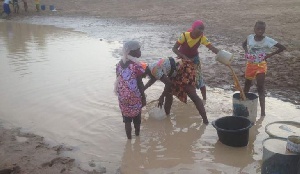Poor and desperate residents of Nanton Kpawomo in Sagnarigu municipality of the Northern region use cement as chemical to treat water before consumption, as rainfalls delay triggered the worst water crisis situation in the community.
The only supply of drinking water, for two other communities, is a hand dug dam and contaminated waterhole located in the Northeast outskirt of the village, which is almost completely dried up as the dry season in the region stretches to seemingly unprecedented level.
The water left in the pond has become muddy and chocolate in color which residents scramble every dawn and during sun fall to collect and boil before adding the harmful cement substance to further purify it before drinking and using to prepare meals and for many other purpose.
Residents say, the situation is not new. They disclosed that similar situation five decades ago forced them out in a communal labor to dig the dam which has remained their only source of water and being shared with animals. Before they dug the dam, they walked several distance to collect water from contaminated dams and puddles.
Zakaria Alhassan, youth chief of the community told Starr News that residents mostly use alum to purify the muddy liquid before usage but those who cannot afford are forced to fall on leftover sand of cement to treat the water.

“At certain point when we do not have money to buy alum, do you know cement can be used for purification? Just fill up your container, the women know how to mix it. They would fetch little sand of cement and mix in the water with their hand, a few minutes later, you’ll see a mixture will appear on the surface of the water which they would collect and throw away,” he said, adding “this is what we’ve been drinking all these years.”
Women who spoke to Starr News in the native Dagbani language at the squalid dam site said they had to rely on the muddy liquid because they could not afford to buy water brought from a dam in another village by a tanker run by a profit oriented operator.
Others said they preferred to collect the muddy liquid from the dam because the water being sold to them are costly but with little difference in quality. A bevy of young ladies who arrived with their rusty containers said some of their families who could not wait for long minutes for the purification turn to drink the muddy liquid.

One of them shyly disclosed they have been taking their bath once every day for many days now. She said they use the muddy water for all activities that require water and challenged Starr News to follow her home to witness how her elder would prepare a meal with the one collected.
Incidents like these, though abundantly common, is a stark reminder of symbolic state failures and increasing poverty in the region home to dozen of poverty alleviation aid agencies and experts.
The community has a total population of about 1,200, found around Fou and Taha, with no single basic infrastructure. The only four classroom school building which is currently with broken doors and windows was built by an aid agency for orphans but parents have refused to allow their children to attend the school, insisting the children are not orphans.
There is no access road to the community and the people are cut off during rainy seasons. Residents seek healthcare in neighboring communities and the only state sponsored infrastructure is the extension of electricity power.
A sub chief, Bomaha-Naa Sayibu Nindoo said the situation has compelled the palace to exact GH¢300 from every landowner and breadwinners to fund a safe drinking water extension into the community. He commended their efforts so far and was optimistic that the project would be successful with or without any assistance from the state.
“The situation is truly severe; one medium sized container is at a cost of GH¢5, dam water. There is no school building in this community not even a good kiosk (drug store). There is nothing here coming from government. Look at how we are closer to Tamale. Your wife cannot wash and your animals will die if there is no water, and so where is the assistance from government? Sometime ago, government used to intervene in situations like ours, there is no such thing again,” the chief lamented.
The youth chief expressed concerns that the community feel neglected by the state and predict they may consider pulling out from democratic processes including levying residents to develop the community.
Regional News of Tuesday, 3 April 2018
Source: starrfmonline.com

















